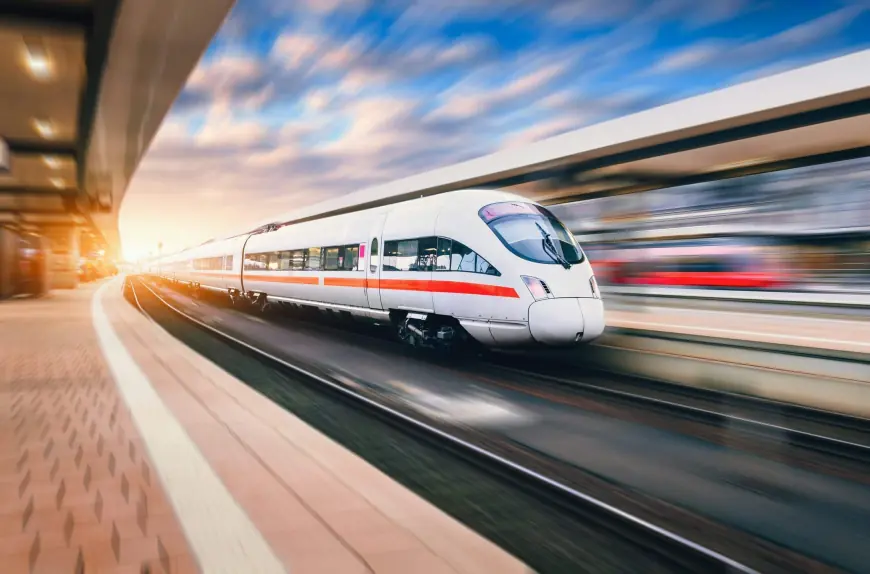Middle East Connected Rail Market 2030 Growth Opportunities
Safety and security are critical in the Middle East, given its geopolitical sensitivity and focus on passenger and cargo protection.

Introduction
The Middle East is undergoing a remarkable transformation in its transportation infrastructure, with connected rail systems emerging as one of the most critical components of this evolution. According to TechSci Research, the Middle East Connected Rail Market, valued at USD 1.48 billion in 2024, is projected to reach USD 2.31 billion by 2030, expanding at a CAGR of 7.72%. This strong growth trajectory underscores the region’s commitment to building sustainable, technologically advanced, and passenger-friendly transportation networks.
Connected rail technology integrates cutting-edge solutions such as the Internet of Things (IoT), Artificial Intelligence (AI), Big Data analytics, and automation systems to create smarter and more efficient railway operations. These advancements are reshaping traditional railways into modern networks that enhance safety, reduce costs, and elevate passenger experiences.
The growing demand for eco-friendly mobility solutions, coupled with population growth, rapid urbanization, and government-backed infrastructure investments, is fueling the adoption of connected rail systems. The sector is set to become a cornerstone of the Middle East’s long-term vision for sustainable development and regional connectivity.
Emerging Trends in the Middle East Connected Rail Market
1. Digital Transformation of Railways
One of the most prominent trends is the digital transformation of railway networks. Technologies such as AI-driven predictive maintenance, IoT-enabled sensors, and real-time passenger information systems are revolutionizing operations. Digital tools are reducing downtime, enhancing scheduling accuracy, and improving passenger convenience.
2. Adoption of Automated Fare Collection (AFC) Systems
The demand for contactless ticketing solutions has surged across the Middle East. Automated Fare Collection systems integrate seamlessly with mobile wallets and digital payment platforms, simplifying ticketing while providing valuable data analytics for operators. AFC is now viewed as a backbone of smart city transport ecosystems.
3. Integration of AI and Big Data Analytics
Railway operators are increasingly leveraging AI algorithms and Big Data analytics to optimize routes, improve energy efficiency, and enhance passenger safety. Predictive analytics help in detecting potential system failures before they occur, reducing maintenance costs and improving service reliability.
4. Focus on Sustainability and Green Mobility
With global attention shifting toward climate change and carbon reduction, connected rail systems are being designed to minimize environmental impact. The adoption of electric multiple units (EMUs) and energy-efficient rolling stock reflects the region’s determination to achieve sustainability goals.
5. Smart City Initiatives Driving Rail Growth
Countries like the UAE, Saudi Arabia, and Turkey are embedding rail projects into broader smart city frameworks. Connected rail systems act as the backbone of these cities, ensuring seamless, multimodal transportation that aligns with future-ready urban planning.
Download Free Sample Report: https://www.techsciresearch.com/sample-report.aspx?cid=1694
Market Drivers
1. Rapid Urbanization and Population Growth
The Middle East’s major cities, such as Dubai, Riyadh, and Istanbul, are experiencing unprecedented population growth. This surge in urban populations demands efficient public transportation systems, positioning connected rail as the most viable solution to address congestion and mobility challenges.
2. Government Investments in Infrastructure
Governments across the Middle East are allocating significant budgets toward modern rail infrastructure. Initiatives such as high-speed rail projects, metro expansions, and urban transit upgrades highlight the political will to reduce reliance on road transport and improve sustainability.
3. Rising Demand for Eco-Friendly Transport
Environmental sustainability is a key driver, with connected rail offering a low-emission alternative to traditional modes of transport. The Middle East’s ambitious targets for reducing carbon footprints are accelerating the adoption of green mobility solutions.
4. Technological Advancements in Rail Systems
The integration of IoT, AI, and automation is enabling greater efficiency, safety, and reliability. These innovations not only improve operational performance but also enhance passenger satisfaction through features like real-time updates and seamless ticketing.
5. Growth of Tourism and Trade
Countries like Turkey and the UAE are witnessing booming tourism and trade sectors, which require robust, reliable, and efficient transportation systems. Connected rail ensures smooth movement of both people and goods, thereby supporting economic growth.
Industry Key Highlights
- Market Valuation: USD 1.48 billion in 2024, projected to reach USD 2.31 billion by 2030.
- CAGR: 7.72% during 2024–2030.
- Fastest-Growing Service Segment: Automated Fare Collection (AFC) systems.
- Fastest-Growing Country: Turkey, owing to its strategic geographical location and ambitious infrastructure projects.
- Technology Drivers: IoT, AI, and Big Data analytics transforming traditional rail operations into smarter, connected ecosystems.
- Strategic Focus: Sustainability, smart city integration, and enhanced passenger experience.
Segmental Insights
By Services
- Automated Fare Collection (AFC): Expected to be the fastest-growing segment due to its convenience and integration with digital wallets.
- Passenger Information Systems (PIS): Enhances transparency and real-time communication.
- Train Tracking & Monitoring Solutions: Improves operational efficiency and safety.
- IP Video Surveillance: Strengthening passenger safety and security in public transport.
By Rolling Stock Type
- Electric Multiple Units (EMU): Driving sustainable mobility with reduced emissions.
- Diesel Locomotives: Still relevant in freight and long-haul routes.
- Light Rail/Tram Cars: Growing adoption in urban areas for short-distance commuting.
- Freight Wagons: Supporting regional logistics and cross-border trade.
By Safety & Signaling System
- Positive Train Control (PTC): Prevents accidents by automating responses.
- Automated Train Control (ATC): Enhances scheduling and speed management.
- Communication-Based Train Control (CBTC): Improving network capacity and efficiency.
Regional Insights
Turkey: The Fastest-Growing Market
Turkey’s strategic location bridging Europe, Asia, and the Middle East, coupled with its large-scale investments in urban transit and high-speed rail projects, makes it the most dynamic region in the Middle East connected rail market. Its integration of smart city infrastructure with IoT and AI-based rail technologies positions it as a regional leader.
GCC Countries: Embracing Smart Mobility
The UAE and Saudi Arabia are investing heavily in metro projects and high-speed rail systems to align with Vision 2030 strategies. These projects are not only reducing traffic congestion but also reinforcing the region’s commitment to sustainability.
Rest of the Middle East
Countries like Qatar, Oman, and Kuwait are also expanding their rail infrastructure as part of broader economic diversification strategies, particularly to support tourism and trade.
Competitive Analysis
The Middle East Connected Rail Market is highly competitive, with global technology leaders and regional players striving for dominance. Companies are focusing on strategic collaborations, technological innovations, and government partnerships to strengthen their market presence.
Key Players
- Trimble, Inc. – Specializing in rail technology and automation solutions.
- Hitachi Limited – Providing integrated rail systems with a focus on sustainability.
- Siemens AG – Offering cutting-edge digital rail solutions across the region.
- IBM Corporation – Leveraging AI and data analytics for smart rail operations.
- Cisco Systems, Inc. – Driving connectivity and IoT solutions for rail networks.
- Wabtec Corporation – Focused on safety and signaling systems.
- Tech Mahindra Limited – Delivering IT-enabled rail solutions and smart mobility services.
- Nokia Corporation – Strengthening communication networks for rail operators.
- Huawei Investment & Holding Co., Ltd. – Expanding presence in connected infrastructure technologies.
- CalAmp Corp. – Providing telematics and real-time monitoring solutions.
Future Outlook
The Middle East Connected Rail Market holds tremendous potential over the coming decade. By 2030, railways are expected to serve as the backbone of sustainable transportation in the region. With continuous investments in smart city development, environmental goals, and regional integration, connected rail systems will play a transformative role in mobility and logistics.
- Urban Mobility Revolution: Rail will become central to smart city ecosystems.
- Greener Transport Systems: Greater adoption of EMUs and electric locomotives.
- Advanced Passenger Experience: Contactless ticketing, real-time updates, and personalized travel services.
- Regional Connectivity: Cross-border rail networks to boost trade and tourism.
- Private-Public Partnerships: Collaboration to accelerate innovation and funding.
10 Benefits of the Research Report
- Provides detailed market size, share, and growth forecasts until 2030.
- Offers insights into emerging trends shaping the industry.
- Identifies key drivers, challenges, and opportunities in the market.
- Breaks down the market by services, rolling stock, and signaling systems.
- Analyzes regional dynamics with a focus on Turkey and GCC countries.
- Covers the competitive landscape with profiles of major players.
- Highlights the impact of technological innovations such as IoT, AI, and Big Data.
- Provides investment insights for businesses and policymakers.
- Supports decision-makers with data-driven strategies for market entry or expansion.
- Assists stakeholders in identifying growth hotspots and future opportunities.
Conclusion
The Middle East Connected Rail Market is not just an infrastructure story; it is a narrative of technological transformation, sustainability, and regional development. With governments, private players, and technology innovators coming together, the market is set to redefine the mobility landscape across the region. By 2030, connected rail will not only ease congestion and reduce emissions but will also serve as a catalyst for economic growth, smart city evolution, and cross-border connectivity.
Contact Us-
Mr. Ken Mathews
708 Third Avenue,
Manhattan, NY,
New York – 10017
Tel: +1-646-360-1656
Email: [email protected]
Website: www.techsciresearch.com
What's Your Reaction?
 Like
0
Like
0
 Dislike
0
Dislike
0
 Love
0
Love
0
 Funny
0
Funny
0
 Angry
0
Angry
0
 Sad
0
Sad
0
 Wow
0
Wow
0




















































